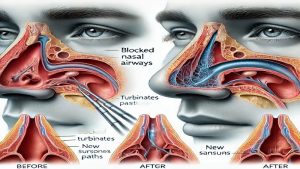Techniques, benefits and challenges
Introduction
Nasal airway obstruction is one of the most common problems among patients that can cause respiratory problems, SnoringШҢ Sleep Apnea, Reduced sense of smell and reduced quality of life. In cases where drug therapies or non -invasive procedures such as the use of nasal sprays and sinuses are not effective, the creation of new respiratory pathways through surgical procedures, such as turbine, septoplasty and other nasal reconstruction techniques, is considered as an essential solution.. In this article from the site of Dr. Behnam Khorrami (Isfahan nose surgeon _ Jaw surgeon of Isfahan), Examines a variety of techniques for opening respiratory roads, their benefits and related challenges..
Causes of obstruction of nasal airways
1. Deviated septum (ШіЩҫШӘЩҲЩ…)
Deviated septum (Septum Division) A state is said to be a bone-bone wall of the nose (ШіЩҫШӘЩҲЩ…) Diverted from the middle line and reduces the flow of inlet air from one or both nostrils. This problem can be congenital or caused by a nose impulse.
2. Nasal turbines (Nasal tentacles) Swell
Turbines (Conha) Bone structures are intra -nose that are covered with soft tissue. Excessive swelling of turbines, especially lower turbine (Inferior Turbinate), Can cause airway blockage and disturbances in breathing.
3. Nasal polyps
Nasal polyps Abnormal growth of soft tissues inside the nasal cavity that can block the respiratory tract.. This problem is usually with allergies and chronic inflammation of sinuses (Chronic sinusitis) Relevant.
4. Soft tissue hypertrophy
The enlargement of soft tissues inside the nose, such as mucosal glands, can lead to obstruction of the airways. This problem is usually caused by allergies, chronic inflammation, or recurrent infections..
5. Nose stenosis
Nasal valves (The inner areas of the nostrils) If they are narrowed for congenital or injury reasons, they can limit the flow of inlet air to the nose.
Surgical methods to create new respiratory ways
1. ШіЩҫШӘЩҲЩҫЩ„Ш§ШіШӘЫҢ (Septoplasty)
ШіЩҫШӘЩҲЩҫЩ„Ш§ШіШӘЫҢ Is a type of surgery to correct nasal blade deflection. This procedure involves removing or deforming part of the bone-rash blade to open the respiratory path.
Do method:
The surgeon enters through the nostril.
The nasal septum's mucus is lifted and the deflected parts of the bone or cartilage are corrected or removed.
Finally, the nasal septum is stabilized in a smooth and central position.
Advantages:
Improve airflow
Reduce snoring
Improve symptoms of sinusitis
2. Engineer (Turbinoplasty)
In this way, parts of nose tentacles (Turbines) That cause obstruction, small or removed.
Do method:
Radiofrequency or laser devices are used to reduce the size of turbines.
In some cases, part of the turbines is removed to provide better air flow.
Advantages:
Rapid breathing recovery
Reducing allergies and congestion symptoms
Long -term results
3. Regeneration of nasal valve (Nasal Valve Reconstruction)
This procedure is performed to correct stenosis or structural weakness of the nasal valve.
Do method:
Use of cartilage bonding from nasal blade or ear
The reinforcement of the internal structure of the nose
Advantages:
Increase the strength of the valves
Improve respiratory function
Reduce permanent obstruction
4. Polypectomy (Polypectomy)
In this method, nasal polyps that cause blockage are removed.
Do method:
Using surgical or endoscopy tools to remove polyps
Nasal mucosa repair after removal of polyps
Advantages:
Improve the sense of smell
Reducing inflammation and congestion
Improve sleep quality
5. The act of opening the sinuses (Functional Endoscopic Sinus Surgery вҖ“ FESS)
This procedure is done using endoscope to open sinus routes and improve sinuses drainage..
Do method:
Through the nostrils, small tools are entered and the obstruction is removed.
Improves airflow and discharge of sinus secretions
Advantages:
Reducing congestion
Reduce headache and sine pressure
Improve airflow
Post-surgery care
Use of salt sprays: To prevent drying of nose mucosa
Abstaining: To prevent bleeding
Refrain from smoking: Smoking and hookah stimulates the nasal mucosa and slow the recovery process.
Refusal: To reduce the risk of bleeding
Benefits of creating new respiratory paths
Improve sleep quality
Reduce snoring
Increased energy levels due to improvement of oxygenation
Reduce sinus infections
Improve the sense of smell
Potential challenges and complications
Post -operative bleeding
The infection
Swelling and bruising
The creation of ulcers or adhesion in the nose
The probability of the need for restorative action
Conclusion
Creating new respiratory ways through surgical procedures such as septoplasty, turbine and nasal regeneration is an effective solution to improve respiratory problems caused by nasal obstruction.. Choosing the appropriate treatment depends on the main cause of obstruction and specific conditions of the patient.
Useful links:
Isfahan nose surgeon _ Jaw surgeon of Isfahan
Dr. Behnam Khorrami's page in the clinic 24 | Maxillofacial surgeon in Isfahan clinic 24 | Nose surgeon in Isfahan clinic 24
Dr. Behnam Khorrami, nose surgeon in Isfahan at Dr. Af | Maxillofacial surgeon in Isfahan at Dr. Af | Isfahan nose surgeon at Dr. Af
